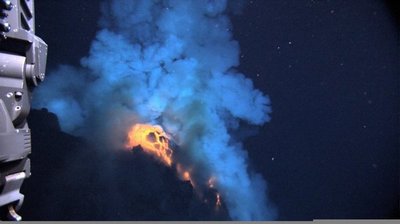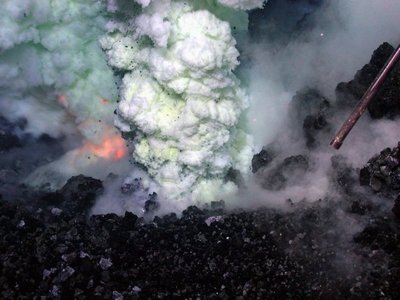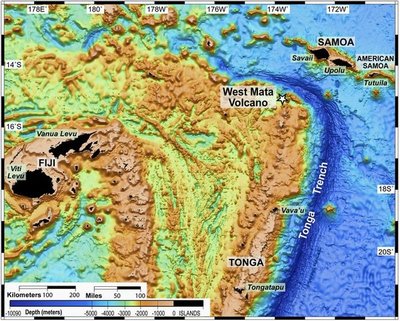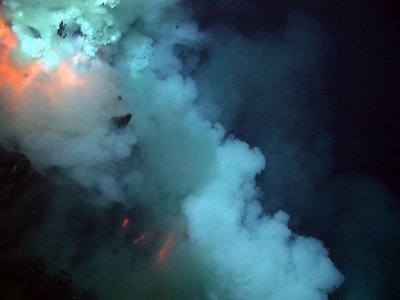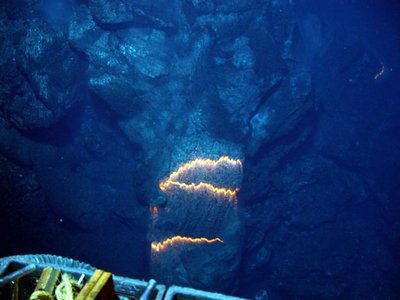December 17, 2009
Scientists witness for first time magma streaming from volcano in deep ocean
For the first time scientists have seen molten lava flowing from a deep-ocean seafloor volcano, exploding into 35-foot-long streams of red and gold and rising as bubbles as much as 3 feet across.
“Volcanic rocks, especially pillow basalts, are one of the most common rock forms on Earth, and yet no one has ever seen them forming in the deep ocean before,” said University of Washington oceanographer Joe Resing, chief scientist of an expedition earlier this year when scientists witnessed the sight at a volcano 4,000 feet below the surface. “More than 80 percent of volcanic eruptions take place underwater and we’ve made completely new observations to better understand fundamental processes shaping our Earth.”
Video was released for the first time to the media today during the American Geophysical Union meeting in San Francisco. In the footage, clouds of milky-yellow sulfur gas billow vigorously, molten red lava explodes into the icy ocean water and turns almost instantaneously to black rock while water vapor creates huge, glowing lava bubbles several feet across. The video was recorded during a May 5 to 13, 2009, expedition to West Mata volcano, about 125 miles southwest of Samoa, funded by the National Oceanic and Atmospheric Administration and the National Science Foundation.
Watch the clip on YouTube at http://www.youtube.com/watch?v=eERsy1IO4LM.
This is only the second seafloor volcanic eruption ever seen. The other, found in 2004 and revisited by oceanographers this past April, is near Guam. It sends explosions of debris, gases and steam into the ocean, but no flows of molten lava have been observed at that site.
All other expeditions that have traveled to sites with telltale signs of eruptions either have been unable to find active eruptions or arrived after the action was over.
The video released publicly this week is not only great for TV, it’s useful.
“The whole ocean floor is created by this process of extruded lava but we’ve never seen it so we don’t know how rapidly this occurs, the volume of rock produced or how these eruptions build lava flows hundreds of meters thick,” said Robert Embly, a seafloor geologist with the National Oceanic and Atmospheric Administration and Oregon State University’s Hatfield Marine Science Center. Embley, who was co-chief scientist on the expedition, said he’s waited his whole 42-year career for a chance to see this.
Seeing seafloor eruptions might also be a way to better understand eruptions that occur on land because scientists can get so much closer to the ones on the seafloor, Resing says
For one thing, the recent eruption occurred so deep that water pressures tamped down gas explosions and limited how far molten lava spewed. The streams of lava seen shooting up to 35 feet in the water and volcanic rock fragments thrown 150 to 300 feet from the eruption would have been even more expansive in air. Also, oceanographers have unmanned, remotely operated vehicles that can maneuver near molten magma unlike anything available on land. During the expedition, for instance, the remotely operated vehicle worked within eight feet of the eruption site to insert instruments into billowing water and gases.
Scientists found evidence that eruptions were taking place six months before the expedition where lava flows were seen. UW oceanography professor Marv Lilley was on that November 2008 expedition and recorded very high hydrogen concentrations in the water.
“I knew that these high levels could only be produced during an active eruption,” Lilley says.
The findings merited a return expedition aboard the UW’s research vessel, the Thomas G. Thompson. Scientists zeroed in on the summit of a small volcano and found eruptive activity in an area 325 feet long with big vents at either end. The most violently erupting vent with molten lava was named Hades. The other vent, Prometheus, was erupting with low-level, nearly continuous fire fountains and ejecting debris.
Scientists were surprised to find boninite lavas, believed to be among the hottest lavas that erupt on Earth. These had only been previously found long solidified at old, extinct volcanoes.
Resing and other scientists wonder what kind of volcano this is. One possibility is an arc volcano, which forms above regions in the ocean where one tectonic plate is sliding under another.
Arc volcanoes are most commonly found in the Pacific Ocean and have resulted in creation of such island-arc chains found in Hawaii, Aleutians and Japan.
Resing is a chemical oceanographer whose UW appointment is through NOAA and the Joint Institute for the Study of the Atmosphere and Oceans based at the UW. Other scientists on the expedition included those from the University of Hawaii, Monterey Bay Aquarium Research Institute, Western Washington University, Marine Biological Laboratory, Woods Hole Oceanographic Institution, Portland State University, Harvard University, University of Tulsa, California State University’s Moss Landing Marine Laboratory, University of California Santa Cruz and Lamont Doherty Earth Observatory.
###
For more information:
Resing: resing@u.washington.edu; to reach Resing by phone during AGU contact Sandra Hines, 206-543-2580; after AGU his office phone is 206-526-6184
Tag(s): Joe Resing • oceanography • RV Thomas G. Thompson